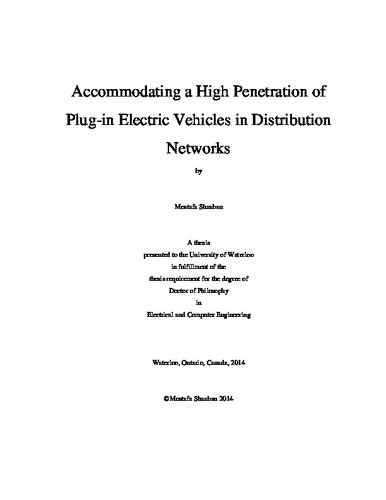| dc.description.abstract | The last few decades have seen growing concern about climate change caused by global warming, and it now seems that the very future of humanity depends on saving the environment. With recognition of CO2 emissions as the primary cause of global warming, their reduction has become critically important. An effective method of achieving this goal is to focus on the sectors that represent the greatest contribution to these emissions: electricity generation and transportation. For these reasons, the goal of the work presented in this thesis was to address the challenges associated with the accommodation of a high penetration of plug-in electric vehicles (PEVs) in combination with renewable energy sources.
Every utility must consider how to manage the challenges created by PEVs. The current structure of distribution systems is capable of accommodating low PEV penetration; however, high penetration (20 % to 60 %) is expected over the next decades due to the accelerated growth in both the PEV market and emission reduction plans. The energy consumed by such a high penetration of PEVs is expected to add considerable loading on distribution networks, with consequences such as thermal overloading, higher losses, and equipment degradation. A further consideration is that renewable energy resources, which are neither exhaustible nor polluting, currently offer the only clean-energy option and should thus be utilized in place of conventional sources in order to supply the additional transportation-related demand. Otherwise, PEV technology would merely transfer emissions from the transportation sector to the electricity generation sector.
As a means of facilitating the accommodation of high PEV penetration, this thesis proposes methodologies focused on two main themes: uncontrolled and coordinated charging. For uncontrolled charging, which represents current grid conditions, the proposal is to utilize dispatchable and renewable distributed generation (DG) units to address the high PEV penetration in a way that would not be counterproductive. This objective is achieved through three main steps. First, the benefits of allocating renewable DG in distribution systems are investigated, with different methodologies developed for their evaluation. The benefits are defined as the deferral of system upgrade investments, the reduction in the energy losses, and the reliability improvement. The research also includes a proposal for applying the developed methodologies for an assessment of the benefits of renewable DG in a planning approach for the optimal allocation of the DG units. The second step involves the development of a novel probabilistic energy consumption model for uncontrolled PEV charging, which includes consideration of the drivers’ behaviors and ambient temperature effect associated with vehicle usage. The final step integrates the approaches and models developed in the previous two steps, where a long-term dynamic planning approach is developed for the optimal allocation of renewable and dispatchable DG units in order to accommodate the rising penetration of PEV uncontrolled charging. The proposed planning approach is multi-objective and includes consideration of system emissions and costs.
The second theme addressed in this thesis is coordinated PEV charging, which is dependent on the ongoing development of a smart grid communication infrastructure, in which vehicle-grid communication is feasible via appropriate communication pathways. This part of the work led to the development of a proposed coordinated charging architecture that can efficiently improve the performance of the real-time coordinating PEV charging in the smart grid. The architecture is comprised of two novel units: a prediction unit and an optimization unit. The prediction unit provides an accurate forecast of future PEV power demand, and the optimization unit generates optimal coordinated charging/discharging decisions that maximize service reliability, minimize operating costs, and satisfy system constraints. | en |

